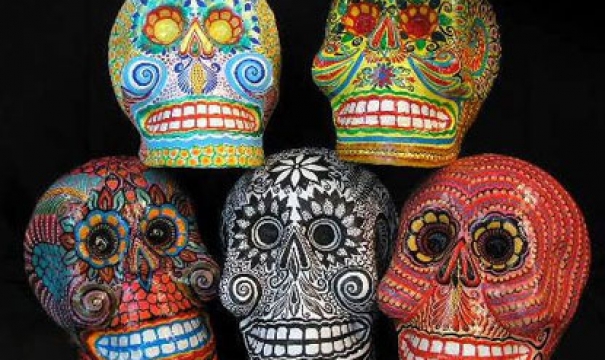
October 28, 2015
Halloween and the Day of the Dead
In the United States, Halloween is the favorite holiday of many -- adults and children alike. Celebrated on October 31, All Hallows' Eve originated from the ancient Celtic festival Samhain (for some reason pronounced "say-win") which celebrated the end of the Gaelic harvest season. The Gaels believed that on that day the boundaries between the worlds of the living and the dead became fluid, allowing the dead to come back to life, bringing illness and other evils. Masks and costumes were worn to appease the dead. Of course, the living were also capable of wreaking havoc. Trick-or-treating, for example, began as a fun bit of extortion: give us a treat or else.
Scottish immigrants brought their versions of Halloween when they came to North America in the 19th century. Other western countries didn't embrace the spooky fun until the late 20th century, developing all the imagery of witches and ghosts, bats and ghouls that delight and terrify.
A similar holiday, celebrated November 1 and 2, comes from southern and central Mexico: Day of the Dead (Dia de los Muertos). The indigenous peoples also believed that, at midnight on October 31, the boundaries between the living and the dead opened, not to let evil into the world, but to allow the spirits of angelitos (deceased children) to reunited with their families for 24 hours. On November 2, the spirits of the adults come to enjoy the festivities prepared for them. That afternoon families go to the cemeteries to clean tombs, listen to music and reminisce about the loved ones no longer with them.
The holiday also corresponds with the annual migration of monarch butterflies, which, according to traditional belief, are the souls of ancestors returning to earth for their annual visit. Such a beautiful thought.
It's a charming variation of our Halloween, based on close family ties and community. It's filled with sugar skulls (calaveritas de azucar), ornate masks, flowers and food. If you've never seen an ornately painted sugar skull, you've missed out. My paternal grandmother was born in Chihuahua, Mexico. I don't know if she ever celebrated this holiday as a child since her father was German, but I'm sure she must have experienced some of the treats.
I modified an image that I found at ColoringShapes.com that would look amazing embroidered. Anyone up for the challenge? (Due to technical difficulties, the image isn't showing up. I'll add it to the pattern library as soon as I can.)
Reference:
Mexican Sugar Skull
Halloween History
Scottish immigrants brought their versions of Halloween when they came to North America in the 19th century. Other western countries didn't embrace the spooky fun until the late 20th century, developing all the imagery of witches and ghosts, bats and ghouls that delight and terrify.
A similar holiday, celebrated November 1 and 2, comes from southern and central Mexico: Day of the Dead (Dia de los Muertos). The indigenous peoples also believed that, at midnight on October 31, the boundaries between the living and the dead opened, not to let evil into the world, but to allow the spirits of angelitos (deceased children) to reunited with their families for 24 hours. On November 2, the spirits of the adults come to enjoy the festivities prepared for them. That afternoon families go to the cemeteries to clean tombs, listen to music and reminisce about the loved ones no longer with them.
The holiday also corresponds with the annual migration of monarch butterflies, which, according to traditional belief, are the souls of ancestors returning to earth for their annual visit. Such a beautiful thought.
It's a charming variation of our Halloween, based on close family ties and community. It's filled with sugar skulls (calaveritas de azucar), ornate masks, flowers and food. If you've never seen an ornately painted sugar skull, you've missed out. My paternal grandmother was born in Chihuahua, Mexico. I don't know if she ever celebrated this holiday as a child since her father was German, but I'm sure she must have experienced some of the treats.
I modified an image that I found at ColoringShapes.com that would look amazing embroidered. Anyone up for the challenge? (Due to technical difficulties, the image isn't showing up. I'll add it to the pattern library as soon as I can.)
Reference:
Mexican Sugar Skull
Halloween History
0 comment + add your own
